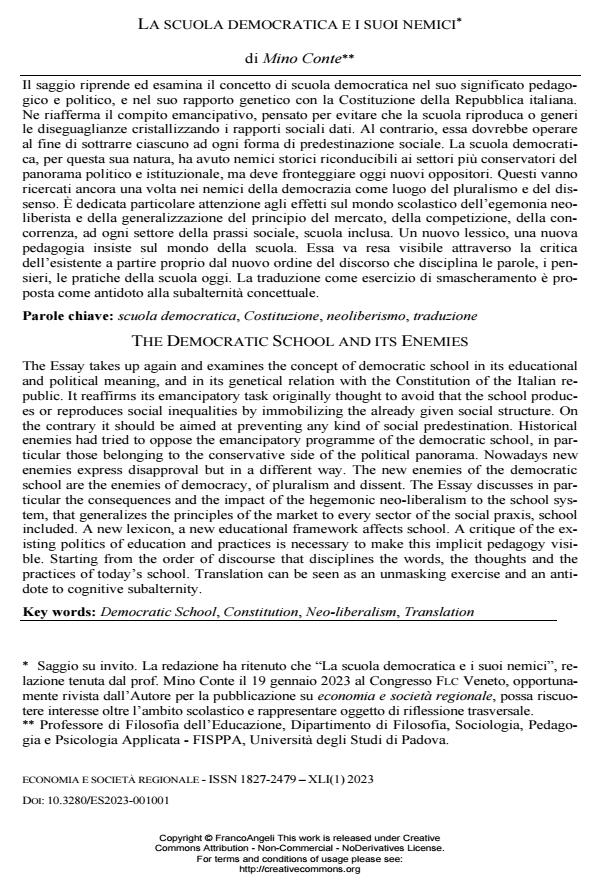The democratic school and its enemies
Journal title ECONOMIA E SOCIETÀ REGIONALE
Author/s Mino Conte
Publishing Year 2023 Issue 2023/1 Language Italian
Pages 11 P. 5-15 File size 248 KB
DOI 10.3280/ES2023-001001
DOI is like a bar code for intellectual property: to have more infomation
click here

FrancoAngeli is member of Publishers International Linking Association, Inc (PILA), a not-for-profit association which run the CrossRef service enabling links to and from online scholarly content.
The Essay takes up again and examines the concept of democratic school in its educational and political meaning, and in its genetical relation with the Constitution of the Italian republic. It reaffirms its emancipatory task originally thought to avoid that the school produces or reproduces social inequalities by immobilizing the already given social structure. On the contrary it should be aimed at preventing any kind of social predestination. Historical enemies had tried to oppose the emancipatory programme of the democratic school, in par- ticular those belonging to the conservative side of the political panorama. Nowadays new enemies express disapproval but in a different way. The new enemies of the democratic school are the enemies of democracy, of pluralism and dissent. The Essay discusses in par- ticular the consequences and the impact of the hegemonic neo-liberalism to the school sys- tem, that generalizes the principles of the market to every sector of the social praxis, school included. A new lexicon, a new educational framework affects school. A critique of the existing politics of education and practices is necessary to make this implicit pedagogy visible. Starting from the order of discourse that disciplines the words, the thoughts and the practices of today’s school. Translation can be seen as an unmasking exercise and an anti- dote to cognitive subalternity.
Keywords: Democratic School, Constitution, Neo-liberalism, Translation
- Adorno T.W. (2010). Teoria della Halbbildung. Genova: Il Melangolo.
- Baldacci M. (2019). La scuola al bivio. Mercato o democrazia?. Milano: FrancoAngeli.
- Barthes R. (1994). Miti d’oggi. Torino: Einaudi.
- Calvano R. (2019). Scuola e Costituzione, tra autonomia e mercato. Roma: Ediesse. Conte M. (2017). Didattica minima. Anacronismi della scuola rinnovata. Padova: libreriauniversitaria.it
- Dardot P., Laval C. (2013). La nuova ragione del mondo. Roma: DeriveApprodi. Dardot P., Laval C. (2016). Guerra alla democrazia. Roma: DeriveApprodi.
- De Carolis M. (2017). Il rovescio della libertà. Macerata: Quodlibet. Ferme V. (2002). Tradurre è tradire. Ravenna: Longo.
- Gadamer H.G. (2012). Bildung e umanesimo. Genova: Il Melangolo. Gramsci A. (2007). Quaderni del carcere. Torino: Einaudi, vol. III. Harwey D. (2005). Breve storia del neoliberismo. Milano: Il Saggiatore.
- Laval C., Vergne F., Clément P., Dreux G. (2010). La nouvelle école capitaliste. Paris: La Découverte.
- Lombardi G. (1967). Contributo allo studio dei doveri costituzionali. Milano: Giuffré.
- Lunghini G. (2012). Conflitto, crisi, incertezza. Torino: Bollati Boringhieri. Luhmann N. (1969). Legitimation durch Verfahren. Neuwied: Luchterhand. Moretti F. (2017). Il borghese. Tra storia e letteratura. Torino: Einaudi.
- Orwell G. (2017). 1984. Milano: Mondadori.
- Rancière J. (2008). Il maestro ignorante. Milano-Udine: Mimesis. Scotto di Luzio A. (2007). La scuola degli Italiani. Bologna: il Mulino. Simonini A. (1978). Il linguaggio di Mussolini. Milano: Bompiani.
- Venuti L. (1998). The scandals of translation. London: Routledge.
Mino Conte, La scuola democratica e i suoi nemici in "ECONOMIA E SOCIETÀ REGIONALE " 1/2023, pp 5-15, DOI: 10.3280/ES2023-001001